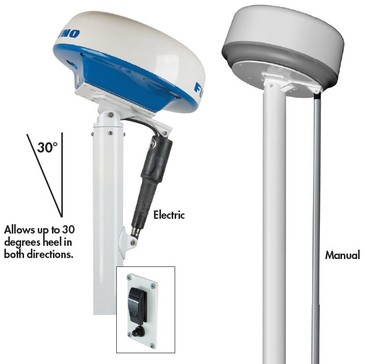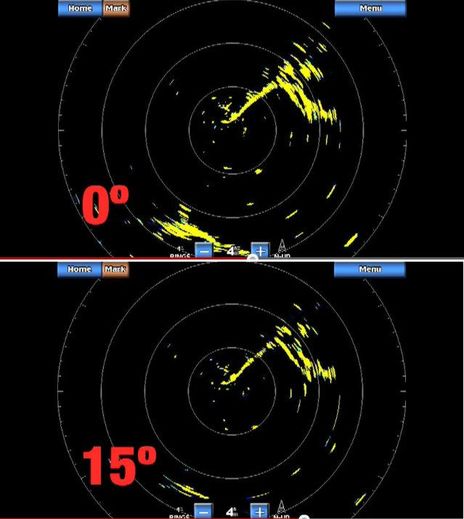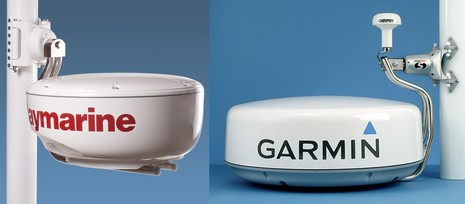Should sailboat radars be leveled, and if so how?

This entry is inspired by Edson's Miami introduction of a Manual Radar Leveling Kit that looks neat to me. I've seen pole mounts like this before--either custom fabricated or made by less familiar companies like Garhauer--and they struck me as a simple and economical way to deal with the issue of decreased radar performance due to boat heel. But before discussing the merits of manual (or electric) leveling mechanisms versus the many self-leveling mounts, I probably ought to address the fact that some sailors reject the whole notion of radar leveling as hokum!...
For instance, I found this emphatic statement on cruisersforum.com: "I NOTICED NO DISCERNIBLE DIFFERENCE BETWEEN THE QUESTUS {self-leveling} PERFORMANCE AND THE CONVENTIONAL POLE MOUNT!!!" And I'm pretty sure it was written by RC Collins, the highly reliable Compass Marine guy I wrote about recently. But it seems obvious to me that tilt must degrade radar perfomance to some degree. That's because radar is designed for maximum performance when aligned to the horizon and that familiar figure of 25 degrees vertical beam width is really just a definition of where the ever-diminishing signal return reaches a certain threshold as the array tilts away from the horizon (as recently discussed on the forum). I think this means that even a little tilt has some effect though it also means that a radar will still paint some targets even when well beyond that confusing 12.5 degrees on either side of horizon figure. (The vagueness of radar beam direction is also worth understanding in regard to radiation dangers).
At any rate, I've never tested my understanding of the radar tilt issue, but thankfully the good folks at Yachting Monthly did. The article itself is posted at Scanstrut (PDF) and there's a YM YouTube video that yielded those screens below. I wasn't surprised to see noticeable target degradation every 5 degrees from 0 to 30, particularly on the high and low sides of the boat, but at lower angles the issue isn't completely obvious and neither is the solution...

Well, there certainly seem to be lots of self-leveling radar mounts for poles, masts, and even backstays. Besides the usual suspects like Scanstrut and PYI SeaView (gear below), there are even two small companies apparently both founded by sailor engineers with their own self-leveling designs, Questus and Waltz Manufacturing. I don't know how all these designs vary in cost and performance, but I have heard that one overall concern is cable wear and, in fact, I'm told that's why Edson has never ventured into gimbaled mounts. I noticed too the Practical Sailor quote (see Questus site) that goes like this; "The hooker in gimbaling is how to prevent the device and the antenna from swinging freely. A sailboat is an engineering laboratory devoted to controlling movement."
True that! Which is one reason I like the tilt and lock design of the Edson manual mechanism (especially when the extra, or upgrade, cost is only $450 or $490, depending on pole size). Then again adjusting it could be a real hassle if you were short tacking in nasty conditions. I guess it really depends how you sail and what you're willing to put up with. And ignoring the leveling issue does not seem an unreasonable choice, either, though I think anyone using radar while heeling ought to aware of the possible performance loss. Any sailors out there with experience or opinions on this subject?


 Share
Share
Slightly off topic but it seems strange that immediately after finishing this entry I learned about an upside down Raymarine radar install on a 246-foot Zeppelin airship. Check out the photo album:
https://www.facebook.com/Raymarine